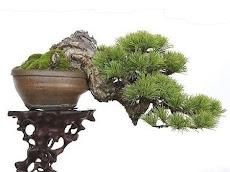by: Patrick Desnoyers
Miniature trees are originally rooted in the mountains of China, where only a specific species of plants and trees grow. Because of its hostile weather conditions, the trees were often stunted and contorted. The strong mountain winds also left these trees twisted in ice and the cold. Essentially, it is nature that has rendered the inspiration for the art of potting trees as students of the art do their best to mimic what nature has created. By “training” trees through specialized means of pruning and shaping them to a desired height and structure, these students of the art were able to recreate the sample nature has provided.
Bonsai, a Japanese term for “miniature potted trees”, actually originated from the Chinese. Called “pensai” in China, these miniature trees first appeared in artworks and poems in this Asian country in 200 B.C. Early own, the mini-tree, or rather, the work of art, has already become a symbol of harmony and tranquility. Chinese Monks and the nobles or upper class, who appreciated the beauty and significance of plants and trees or nature in general, cultivated mini-landscapes of mountains, rivers and little tree houses placed on big plates. Sometime in the 15th or 16th century, this artistic hobby grew among the people of Southeast China. Many of them have become master designers and experts of the art of tree potting. What was first known as a hobby for Chinese artists, monks and nobles in those days became a significant part of modern day Japanese tradition.
How this came to Japan was made possible through the officials of the Japanese government, who often come to China at the height of the Tang Dynasty and have brought the art back home. During the Kamakura period, while Zen Buddhism was introduced in Japan, these Zen masters also introduced the hobby of tree potting to its people. As a result, it became widely popular among the wealthy class (daimyos or feudal lords), the merchants and even the Samurais. In addition to this, daimyos even sought pottery masters on their employ, to make one of kind pots for their miniature plants.
Initially popular among the Japanese priests, the ruling class and those on the upper hierarchy, Bonsai eventually reached popularity with the middle class. As Japanese culture and their way of living dictates it, where the Japanese have always believed in keeping a harmonious relationship with their surroundings as beneficial, miniature gardening became one of Japan's favorite pastimes. The fact that these potted trees took up just a small space inside the house was also compatible with how the Japanese lived. It was during these times too, that the word “bonsai” was coined.
Today, the art of Bonsai is still practiced in China. It is characteristically different from the Japanese versions as they are somewhat bigger than the popular Japanese Bonsai. And while thinking of potted trees, one easily attributes this to Japan, the hobby/art form appeals not only to the people of the East today, but students and enthusiasts all over the world have also become devotees to the art of tree potting.
| About The Author Patrick Desnoyers Avid full time hobby bonsai grower. As been practicing bonsai and gardening for more then 8 years. Owner of http://www.mishobonsai.com, a website with ressource for bonsai seeds and tree seeds. |




No comments:
Post a Comment